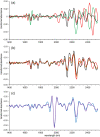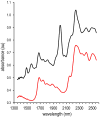On-site forensic analysis of colored seized materials: Detection of brown heroin and MDMA-tablets by a portable NIR spectrometer
- PMID: 35968822
- PMCID: PMC9804980
- DOI: 10.1002/dta.3356
On-site forensic analysis of colored seized materials: Detection of brown heroin and MDMA-tablets by a portable NIR spectrometer
Abstract
The increasing workload for forensic laboratories and the expanding complexity of the drug market necessitates efficient approaches to detect drugs of abuse. Identification directly at the scene of crime enables investigative forces to make rapid decisions. Additionally, on-site identification of the material also leads to considerable efficiency and cost benefits. As such, paperwork, transportation, and time-consuming analysis in a laboratory may be avoided. Near-infrared (NIR) spectroscopy is an analysis technique suitable for rapid drug testing using portable equipment. A possible limitation of spectroscopic analysis concerns the complexity of seized materials. NIR measurements represent composite spectra for mixtures and diagnostic spectral features can be obscured by excipients such as colorants. Herein, a NIR-based (1300-2600 nm) detection of heroin and MDMA in colored casework (i.e., brown powders and ecstasy tablets) using a portable analyzer is presented. The application includes a multistage data analysis model based on the net analyte signal (NAS) approach. This identification model was specifically designed for mixture analysis and requires a limited set of pure reference spectra only. Consequently, model calibration efforts are reduced to a minimum. A total of 549 forensic samples was tested comprising brown heroine samples and a variety of colored tablets with different active ingredients. This investigation led to a >99% true negative and >93% true positive rate for heroin and MDMA. These results show that accurate on-site detection in colored casework is possible using NIR spectroscopy combined with an efficient data analysis model. These findings may eventually help in the transition of routine forensic laboratories from laboratory-based techniques to portable equipment operated on scene.
Keywords: colored samples; forensic casework analysis; illicit drug analysis; near-infrared spectroscopy; portable devices.
© 2022 The Authors. Drug Testing and Analysis published by John Wiley & Sons Ltd.
Conflict of interest statement
HJR is managing partner at TIPb, the company commercializing the Powder Puck sensor.
Figures




Similar articles
-
Portable NIR spectroscopy: the route to green analytical chemistry.Front Chem. 2023 Sep 25;11:1214825. doi: 10.3389/fchem.2023.1214825. eCollection 2023. Front Chem. 2023. PMID: 37818482 Free PMC article. Review.
-
A calibration friendly approach to identify drugs of abuse mixtures with a portable near-infrared analyzer.Drug Test Anal. 2022 Jun;14(6):1089-1101. doi: 10.1002/dta.3231. Epub 2022 Feb 9. Drug Test Anal. 2022. PMID: 35098685 Free PMC article.
-
Dataset of near-infrared spectral data of illicit-drugs and forensic casework samples analyzed by five portable spectrometers operating in different wavelength ranges.Data Brief. 2022 Oct 7;45:108660. doi: 10.1016/j.dib.2022.108660. eCollection 2022 Dec. Data Brief. 2022. PMID: 36425973 Free PMC article.
-
Combining attenuated total reflectance- infrared spectroscopy and chemometrics for the identification and the dosage estimation of MDMA tablets.Talanta. 2019 Apr 1;195:142-151. doi: 10.1016/j.talanta.2018.11.027. Epub 2018 Nov 12. Talanta. 2019. PMID: 30625524
-
QCM Sensor Arrays, Electroanalytical Techniques and NIR Spectroscopy Coupled to Multivariate Analysis for Quality Assessment of Food Products, Raw Materials, Ingredients and Foodborne Pathogen Detection: Challenges and Breakthroughs.Sensors (Basel). 2020 Dec 7;20(23):6982. doi: 10.3390/s20236982. Sensors (Basel). 2020. PMID: 33297345 Free PMC article. Review.
Cited by
-
Rapid and On-Scene Chemical Identification of Intact Explosives with Portable Near-Infrared Spectroscopy and Multivariate Data Analysis.Sensors (Basel). 2023 Apr 7;23(8):3804. doi: 10.3390/s23083804. Sensors (Basel). 2023. PMID: 37112149 Free PMC article.
-
Progress on the Electrochemical Sensing of Illicit Drugs.Adv Biochem Eng Biotechnol. 2024;187:413-442. doi: 10.1007/10_2023_239. Adv Biochem Eng Biotechnol. 2024. PMID: 38273206 Review.
-
Portable NIR spectroscopy: the route to green analytical chemistry.Front Chem. 2023 Sep 25;11:1214825. doi: 10.3389/fchem.2023.1214825. eCollection 2023. Front Chem. 2023. PMID: 37818482 Free PMC article. Review.
-
Additively manufactured ready-to-use platform using conductive recycled PLA for ketamine sensing.Mikrochim Acta. 2025 Jan 9;192(2):60. doi: 10.1007/s00604-024-06902-3. Mikrochim Acta. 2025. PMID: 39779543
-
Forensic Analysis of Synthetic Cathinones on Nanomaterials-Based Platforms: Chemometric-Assisted Voltametric and UPLC-MS/MS Investigation.Nanomaterials (Basel). 2023 Aug 22;13(17):2393. doi: 10.3390/nano13172393. Nanomaterials (Basel). 2023. PMID: 37686901 Free PMC article.
References
-
- World Drug Report . 2021. United Nations: Office on Drugs and Crime. https://www.unodc.org/unodc/en/data-and-analysis/wdr2021.html. Accessed March 31, 2022.
-
- Pütz M. Application of CE‐ESI‐MS in forensic toxicology: Identification of piperazine‐ derived designer drugs in Ecstasy tablets and of food colorants in illicit drugs. In: Mosbach, Germany: XV. GTFCh Symposium; 2007.
-
- Sharrenbroch L, Tough A, Matthews KH. Characterisation of illicit ecstasy and diazepam tablets by colorant identification. Anal Methods. 2018;10(17):2048‐2055. doi:10.1039/C7AY02921G - DOI
MeSH terms
Substances
LinkOut - more resources
Full Text Sources
Medical
Research Materials
Miscellaneous

